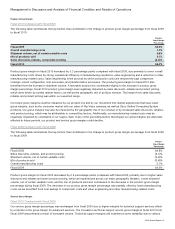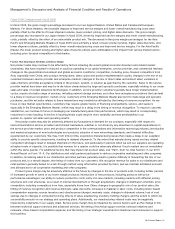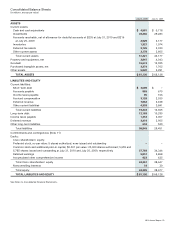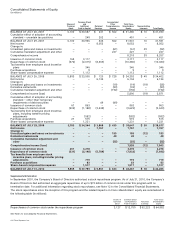Cisco 2010 Annual Report Download - page 34
Download and view the complete annual report
Please find page 34 of the 2010 Cisco annual report below. You can navigate through the pages in the report by either clicking on the pages listed below, or by using the keyword search tool below to find specific information within the annual report.
Management’s Discussion and Analysis of Financial Condition and Results of Operations
Inventories and Purchase Commitments with Contract Manufacturers and Suppliers The following table summarizes our inventories
and purchase commitments with contract manufacturers and suppliers (in millions, except annualized inventory turns):
July 31, 2010 July 25, 2009
Increase
(Decrease)
Inventories $ 1,327 $ 1,074 $ 253
Annualized inventory turns 12.6 11.7 0.9
Purchase commitments with contract manufacturers and suppliers $ 4,319 $ 1,962 $ 2,357
The increase in our purchase commitments with contract manufacturers and suppliers reflects our intent to maintain supply chain
flexibility in support of anticipated higher business volume and longer term product demand projections in our business. Our view is
that in any rapidly shifting supply and demand environment such as the one we are currently experiencing, shifts in lead times,
inventory levels, purchase commitments, and manufacturing outputs will occur. During fiscal 2010 we experienced longer than
normal lead times on several of our products and we continue to see challenges at some of our component suppliers. This was
attributable in part to increasing demand driven by the improvement in our overall markets. In addition, similar to what is happening
throughout the industry, the longer than normal lead times also stemmed from supplier constraints based upon their labor and other
actions taken during the global economic downturn. While we may continue to experience longer than normal lead times, our lead
times improved on the majority of our products in the second half of fiscal 2010, and at the end of fiscal 2010, product lead times
to customers were within a normal range for the majority of our products. We have increased our efforts in procuring components
in order to meet customer expectations which have contributed to an increase in purchase commitments.
Inventories increased during fiscal 2010 as a result of our response to increased demand and also due to the acquisitions of
Tandberg and Starent. Our finished goods consist of distributor inventory and deferred cost of sales and manufactured finished
goods. Distributor inventory and deferred cost of sales are related to unrecognized revenue on shipments to distributors and retail
partners as well as shipments to customers. Manufactured finished goods consist primarily of build-to-order and build-to-stock
products. Service-related spares consist of reusable equipment related to our technical support and warranty activities. All
inventories are accounted for at the lower of cost or market. Inventory is written down based on excess and obsolete inventories
determined primarily by future demand forecasts. Inventory write-downs are measured as the difference between the cost of the
inventory and market, based upon assumptions about future demand, and are charged to the provision for inventory, which is a
component of our cost of sales.
We purchase components from a variety of suppliers and use several contract manufacturers to provide manufacturing
services for our products. During the normal course of business, in order to manage manufacturing lead times and help ensure
adequate component supply, we enter into agreements with contract manufacturers and suppliers that allow them to procure
inventory based upon criteria as defined by us or that establish the parameters defining our requirements and our commitment to
securing manufacturing capacity. A significant portion of our reported purchase commitments arising from these agreements are
firm, noncancelable, and unconditional commitments. In certain instances, these agreements allow us the option to cancel,
reschedule, and adjust our requirements based on our business needs prior to firm orders being placed. Our purchase
commitments are for short-term product manufacturing requirements as well as for commitments to suppliers to secure
manufacturing capacity.
We record a liability, included in other current liabilities, for firm, noncancelable, and unconditional purchase commitments for
quantities in excess of our future demand forecasts consistent with the valuation of our excess and obsolete inventory. The
purchase commitments for inventory are expected to be primarily fulfilled within one year.
Inventory and supply chain management remain areas of focus as we balance the need to maintain supply chain flexibility to
help ensure competitive lead times with the risk of inventory obsolescence because of rapidly changing technology and customer
requirements. We believe the amount of our inventory and purchase commitments is appropriate for our revenue levels.
Financing Receivables and Guarantees The following table summarizes our financing receivables, financing guarantees, and the
related deferred revenue (in millions):
July 31, 2010 July 25, 2009
Increase
(Decrease)
Lease receivables $ 2,196 $ 1,805 $ 391
Financed service contracts 1,773 1,642 131
Loan receivables 1,249 861 388
Gross financing receivables 5,218 4,308 910
Financing guarantees—channel partner 448 334 114
Financing guarantees—end user 304 405 (101)
Gross financing receivables and guarantees 5,970 5,047 923
Allowances for financing receivables (301) (327) 26
Deferred revenue related to financing receivables and guarantees (2,681) (2,639) (42)
Financing receivables and guarantees, net $ 2,988 $ 2,081 $ 907
32 Cisco Systems, Inc.
























